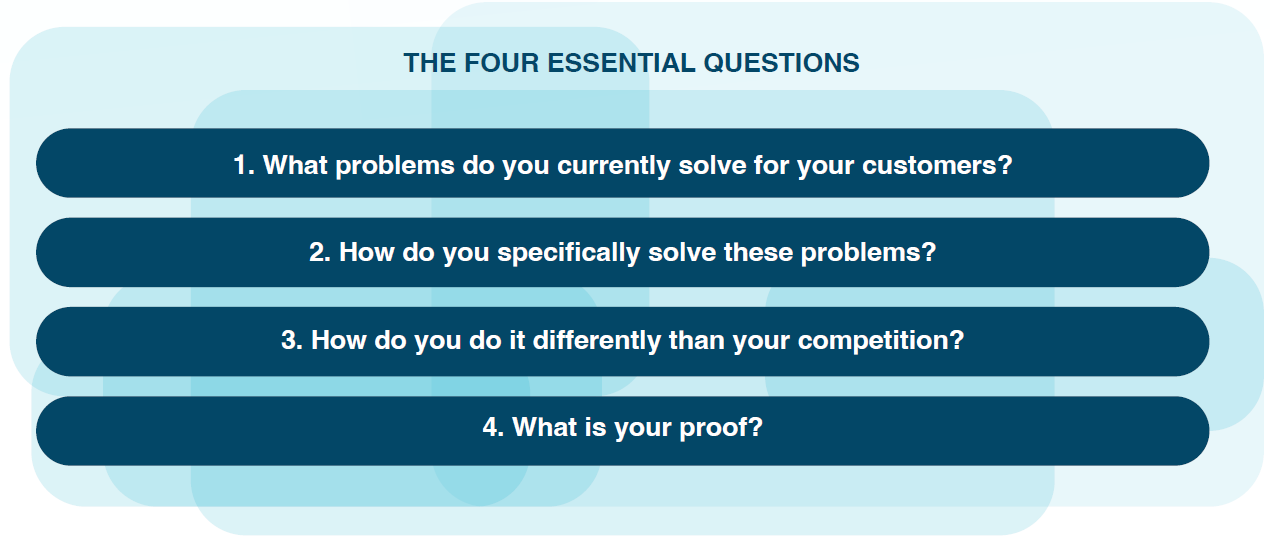We recently hosted a live session on Driving a Revenue Mindset with our Managing Director and Facilitator Brian Walsh. He shared insights on what’s changing in sales, what remains critical, and what the most successful organizations are focusing on to maintain revenue momentum. Be sure to check out the full on-demand recording here.
Today, we’re sharing our top five takeaways from the webinar. Here’s what top revenue leaders are practicing with their teams today to create long-term, repeatable success within their go-to-market motion.
1. Get Aligned on Value to Drive Urgency & Commitment
The first step to implementing a revenue mindset with your team is to generate alignment on your customer value. We ask every organization that we work with these four questions to test for misalignment:

Internal company alignment isn’t enough, though, if your customer-facing team can’t take these answers and apply them in a way that’s meaningful to your customer. That means doing the work to discover what their biggest business pains and desired outcomes are - then connecting them back to your solution in a way that creates and captures value for what that buyer is looking to achieve. For sales teams, that means that the specific way that value is communicated may be different depending on which decision-maker you’re working with and their needs and priorities.
See the action items Brian gave for leaders to start driving this mindset shift:
2. How to Reach Decision-Makers: Coach, Don’t Tell.
When deals are slipping or falling short of their anticipated value, it’s often because the sales team wasn’t able to reach the level of influence in the buying organization needed to access budget for their solution. As sales leaders, we often recognize this problem from a mile away - but we don’t always give enough detail to our teams on how to address it. Reaching decision-makers is a complex process; one that requires guidance and coaching to make it repeatable.
In our discussion, Brian suggests developing a point of view for your revenue team on what typical influencers and decision-makers look like in your ideal customer organization, what their priorities are, and how to approach getting a meeting with them. Then, enable managers to coach to this standard to develop this skill with reps.
Hear his advice to leaders in the clip.
3. Practice Differentiation of Your Process, Not Just Your Solution
Beyond differentiation of your solution, what sets successful organizations apart is a differentiation of how they sell. Data fuels our decisions and our execution, but you can’t train on data. Successful leaders train on how to use that data in conversations that drive great outcomes. Great selling and great business conversations are based on a combination of the knowledge we align our teams on and the art of using it to empower great conversations. When your revenue team executes a motion that helps customers realize a level of success they might not have thought possible, that’s a selling differentiation that drives long-term results.
Brian describes why you have to invest in both the science and the art of selling, and how enabling the use of both across the entire revenue team can transform outcomes, for both your organization and your buyer.
4. Focus on the Long-Term Outcome, Not the Short-Term Win
To drive sustained growth and success, leaders must redirect their teams away from the short-term win of the deal and help them look for ways to drive long-term impact with buyers. The most successful revenue organizations continue to succeed and grow on renewals because their main goal isn’t meeting the number. They focus on capturing and delivering value for the client, knowing that this approach will help them achieve their number and more.
Unfortunately, many leaders harp on team goals without painting the big picture, resulting in tunnel vision and siloing amongst cross-functional teams. Brian gives some great insight on how to bring each contributor into the individual picture, the value they provide within the larger company value, and the need to continue selling even after the deal is signed.
5. Enable Cross-Functional Collaboration to Improve Execution
A huge part of driving a revenue mindset with your team is committing to the concept that everybody sells. That doesn’t mean everyone physically gets in front of the customer to negotiate - rather, it speaks to the idea that every touchpoint in the sales process is a vital time to better understand the buyer, tailor your message to their needs and priorities, and develop an even more powerful value offering.
We might also refer to this as “everybody solves”—everyone on your commercial revenue-generating team is crucial to finding and delivering solutions that improve customer outcomes. When those players are on the same page about the message and the process, opportunities for greater value reveal themselves.
In our discussion, Brian describes how leaders can improve handoffs between critical revenue functions to maximize their effectiveness and value for the buyer.
Start Implementing a Revenue Mindset
We shared even more strategies and considerations for leaders in our full webinar discussion. The one-hour conversation covers how to get your team selling faster, at a higher value, and with better long-term outcomes by focusing on capturing buyer value. We also shared a list of resources that can help you get started. Watch the full replay here.
